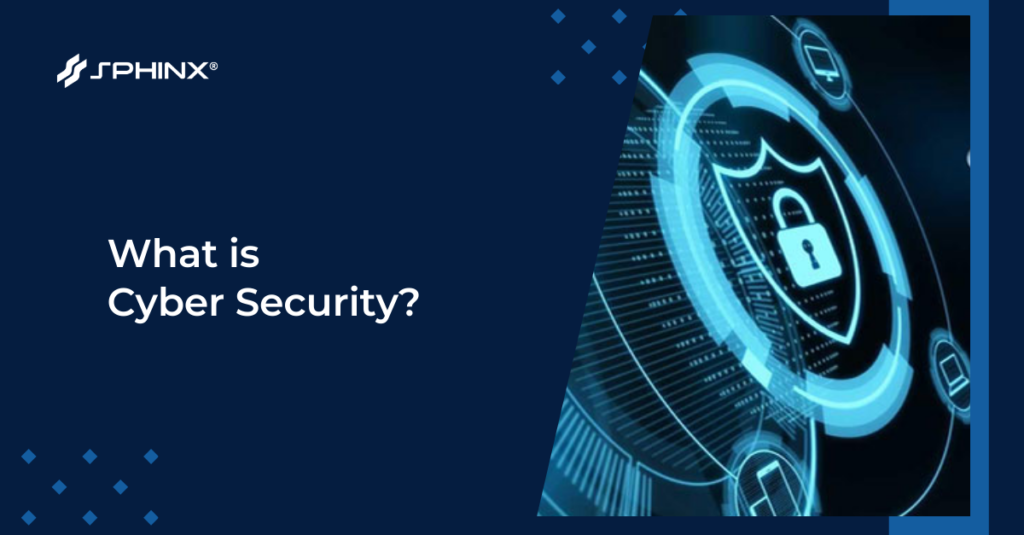It is imperative to guarantee cyber security in a society where technology is becoming more and more integrated into every element of life. Understanding the foundations of cybersecurity is essential for everyone navigating the digital realm, including governments, enterprises, and individuals.
This blog post explores the many forms of cybersecurity and attempts to demystify its fundamentals while also highlighting potential risks.
1. What is Cyber Security?
Cybersecurity is the use of techniques, methods, technology, and policies to prevent or lessen cyberattacks on servers, desktops, mobile devices, electronic systems, networks, and sensitive data. To put it another way, it also has to do with guarding against unwanted access to the enormous volumes of private data we save online as well as on our devices.
Attackers are employing new techniques driven by artificial intelligence (AI) and social manipulation more frequently to get beyond established data security measures. As a result, the cybersecurity industry must change to keep up with new threats and technical advancements in the digital environment.
2. What is the reason for the rise in cyber security?
Businesses are susceptible to disruption, damage, or even destruction by cyberattacks, and the financial damages incurred by victims only increase. As per IBM’s 2023 Cost of Data Breach study, the mean expense incurred by a data breach is at $4.45 million, indicating a 15% surge in the previous three years.
According to projections, by 2025, cybercrime may cost the world economy an astounding $10.5 trillion annually. As the cyber threat landscape evolves, there is a natural rise in worldwide spending on security measures.

Global investment on safety measures is naturally rising as the threat environment for cybersecurity grows
Consequently, the following are the principal advantages of investing in cybersecurity:
- Don’t let cyberattacks lead your company to suffer irreparable harm.
- Reduce the likelihood that necessary security procedures will be broken.
- Drastically lower the chance of a data leak.
- Reduce the effects that supply chain assaults may have on third parties who compromise their security.
3. Type of Cyber Security
3.1. Network Security
Cybersecurity pertains to the implementation of safeguards against unapproved access, abuse, alteration, or denial of service attacks on computer network equipment. It entails technology such as firewalls, intrusion prevention and detection systems (IDPS), virtual private networking (VPNs), and division of networks. The major objectives are to keep internet resources continuously available, stop unwanted access to data, and guarantee that data is private and undisturbed.
3.2. Application Security
Application security guards against unwanted access to and misuse of apps and the information that they are connected with, protecting both based on the cloud and on-premises apps. Additionally, it guards against any flaws in the application’s architecture that would allow attackers to infiltrate the internet. Security precautions and checks for safety are integrated into application development processes using modern methodologies like DevOps and DevSecOps.
3.3. Data Security
Data security is the process of preventing unwanted access, disclosure, alteration, or elimination of private information. This involves deploying encryption, putting in place access rules, categorizing data, and taking precautions to avoid data loss.
- The practice of promptly locating, investigating, and reacting to security events is known as incident response.
- Information security must be maintained by increasing user understanding of security issues.
- Encrypted text is understood as any information that can be protected from unwanted access by using encryption, which transforms data into an incomprehensible format.
3.4. Cloud Security
Cloud security guarantees that a company’s cloud-based assets and services such as virtual servers, apps, data, storage, development instruments, and cloud infrastructure are protected. In other words, a shared responsibility paradigm governs cloud security: the client is in charge of protecting data, code, and other assets stored or performed in the cloud, while the cloud service supplier assumes responsibility for safeguarding the services they offer and the physical structure that encourages them.
3.5. Mobile Security
It comprises safeguarding data—both personal and organizational—stored on mobile devices, including tablets, smartphones, and other comparable models from many malevolent risks, including illegal access, misplaced or stolen hardware and so on.
Mobile devices are already commonplace tools for daily chores. People use mobile phones a lot for personal daily work. Regular data backups on cell phones are essential to reduce the possibility of losing data due to vandalism, harm, or device failure.
Mobile devices often establish connections with a range of networks, including open Wi-Fi, which may leave them vulnerable to safety risks. When using safe connectivity, including encrypted Wi-Fi networks or mobile data connections, it is imperative to give them top priority.
3.6. Endpoint security
Cyberattacks still mostly originate from endpoints, which include servers, PCs, laptops, and handheld devices like Smartphones, tablet. In addition to shielding the network from attackers who use endpoints as launching pads for their criminal acts, endpoint safety is intended to safeguard users and these devices against cyberattacks.
4. Threats to network security
4.1. Malware
Any computer program or piece of software designed specifically to harm a person or computer system is referred to as malware. Cybercriminals and hackers create and utilize malware to take control of devices remotely, access confidential data without authorization, interfere with or harm a computer system, or steal data or systems to extort a large ransom.
4.2. Ransomware
A sort of malicious program known as ransomware is intended to prevent users from accessing documents or the computer systems until a monetary ransom is paid. Ransomware assaults made up 17% of all cyberattacks in 2022, according to the IBM Security 2023 X-Force Threat Intelligence Index.

Ransomware is a cyber security threat
Ransomware is used to spread through many channels including phishing emails, phishing websites, and software bugs. When malware enters the computer’s operating system, it encrypts files or sometimes the entire system, preventing users from accessing data. Once payment is made, the attackers sometimes threaten to remove the files or raise the ransom.
4.3. Cheating
Phishing attacks entail persuading people to download malware, divulge private information, or send money to unidentified parties via email, text, or voice communications. Large-scale phishing campaigns sometimes involve credit card information or phony messages seeming to be from esteemed businesses. The goal of these intricate con games is to steal substantial sums of money or valuable data.
Conclusion
Cybersecurity, to put it briefly, is essential to safeguarding data, networks, and digital systems against evolving cyber threats. As technology develops, solid safeguards are put in place to guarantee that people, businesses, and communities will be resilient in the age of technology.
Please contact our professionals if you require any information concerning cybersecurity.




CEO - Son Le
기타 블로그
블로그
AI Driving Innovation: Key Impacts, Challenges and Market Trends
Artificial Intelligence is rapidly moving from a supportive capability to a central engine of innovation across modern enterprises. Its advancements in automation, generative modeling and real time analytics are redefining how organizations operate, scale and deliver value. As AI becomes embedded into products, workflows and strategic decisions, it is reshaping...
자세히 보기블로그
Top 10 Countries for IT Outsourcing in 2026
IT outsourcing is becoming an increasingly popular strategy as businesses worldwide seek to accelerate digital transformation, reduce operational costs, and access specialized tech talent. With the rapid growth of cloud computing, AI, and software development demands, more companies are turning to global partners to stay competitive and scale efficiently. In...
자세히 보기블로그
Transform Your Business with SAP Consulting Support
In today’s digital-first landscape, enterprise systems must evolve continuously to keep up with rising customer expectations, data complexity, and the demand for operational excellence. SAP plays a central role in this transformation, offering intelligent, integrated solutions that help organizations modernize their operations and drive long-term growth. However, SAP only delivers...
자세히 보기기타 블로그
서비스
IoT 개발
SphinX는 최첨단 IoT 개발 서비스를 제공하여 디바이스를 원활하게 연결하고 혁신적인 솔루션을 제공합니다.
테마서비스
블록체인 개발
우리는 신뢰할 수 있고 안전한 블록체인 기술을 처음부터 설계하는 데 매우 능숙하며, ...
테마서비스
ERP 및 CRM 개발
필요한 ERP & CRM 개발 서비스! 비즈니스 프로세스 간소화 및 조직 효율성 향상....
테마기타 블로그
서비스
IoT 개발
SphinX는 최첨단 IoT 개발 서비스를 제공하여 디바이스를 원활하게 연결하고 혁신적인 솔루션을 제공합니다.
테마서비스
블록체인 개발
우리는 신뢰할 수 있고 안전한 블록체인 기술을 처음부터 설계하는 데 매우 능숙하며, ...
테마서비스
ERP 및 CRM 개발
필요한 ERP & CRM 개발 서비스! 비즈니스 프로세스 간소화 및 조직 효율성 향상....
테마